

The Persona Core Poster – a service design tool. Since years I am working with personas from aspirational to reality.
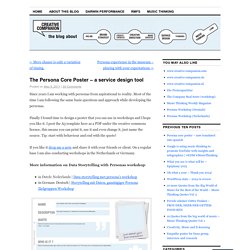
Most of the time I am following the same basic questions and approach while developing the personas. Finally I found time to design a poster that you can use in workshops and I hope you like it. I post the A3 template here as a PDF under the creative commons licence, this means you can print it, use it and even change it, just name the source. Ne vous trompez pas de « personas » Persona Template, for user-centered design process. Persona vs. Archetype: Which Is Better For Design Brainstorming? In my previous article about empathic design, we saw how the designer should put himself in the shoes of users in order to understand their needs and behaviors while using your product or application.
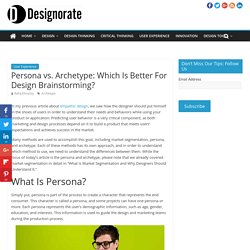
Predicting user behavior is a very critical component, as both marketing and design processes depend on it to build a product that meets users’ expectations and achieves success in the market. Many methods are used to accomplish this goal, including market segmentation, persona, and archetype. Each of these methods has its own approach, and in order to understand which method to use, we need to understand the differences between them.
Le designer est-il un manipulateur manipulé ? - Mais où va le Web. Customer-Centric – Gamestorming. Object of Play Scott Sehlhorst, President of Tyner Blain LLC, has developed an ingenious way to guide the development of your product by identifying your stakeholders.
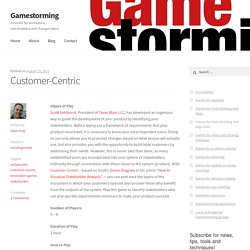
Before laying out a framework of requirements that your product must meet, it is necessary to know your most important users. Doing so not only allows you to prioritize changes based on what people will actually use, but also provides you with the opportunity to build loyal customers by addressing their needs. Personas are real people with changing needs – Design at IBM – Medium. As IBM Designers, we are well versed in the vernacular of IBM Design Thinking.
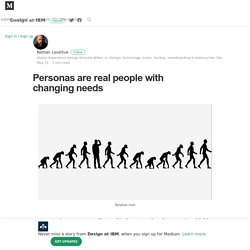
We speak the language of hills, maps, loops, and personas. This story explores the last term in that list: personas. As a designer, I continually advocate the importance of a strong persona. And, I believe, these personas need to be reevaluated and evolve throughout design thinking to continue to portray the real people we are designing for. A simple web search will yield the following: persona (Latin) — mask, character played by an actor. The word reflects the world of theater, and how those who take the stage become someone else. In the practice of IBM Design Thinking, there are several methods used to develop personas. In fact, there is documentation prepared showcasing these IBM efforts. Usability.gov. The purpose of personas is to create reliable and realistic representations of your key audience segments for reference. DIY User Personas. The Encyclopedia of Human-Computer Interaction, 2nd Ed. The persona method has developed from being a method for IT system development to being used in many other contexts, including development of products, marketing, planning of communication, and service design.
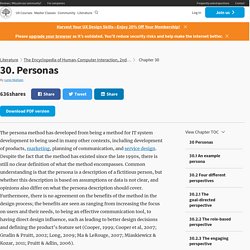
Despite the fact that the method has existed since the late 1990s, there is still no clear definition of what the method encompasses. Interaction Design Foundation. Les personas dans le Design thinking - NovoLaB. Le premier à avoir imaginé le concept des personas est Alan Cooper dans son livre The Inmates are Running the Asylum.

Son idée est de personnifier les utilisateurs de logiciels pour aider les développeurs à identifier les questions auxquelles pourraient être confronter les utilisateurs de ce logiciel. Le concept s’est élargi au marketing puis au Design thinking. L’idée est la même : identifier les clients auxquels sont destinés les services et produits créés. Using Persona Empathy Mapping to Understand User Behavior. Persona is one of the tools that is used to build a better understanding of user behavior either in UX research or in marketing research by building a virtual avatar that represents the target consumer’s characteristics.
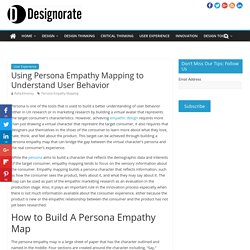
However, achieving empathic design requires more than just drawing a virtual character that represent the target consumer, it also requires that designers put themselves in the shoes of the consumer to learn more about what they love, hate, think, and feel about the product. This target can be achieved through building a persona empathy map that can bridge the gap between the virtual character’s persona and the real consumer’s experience. While the persona aims to build a character that reflects the demographic data and interests of the target consumer, empathy mapping tends to focus on the sensory information about the consumer.
Creating Personas – prototypr. Getting started with IBM Design Thinking - practice - IBM Cloud Garage Method. Align.

Learning Resources. Personas. Stage 1 in the Design Thinking Process: Empathise with Your Users. Design Thinking cannot begin without a deeper understanding of the people you are designing for.

4 Common Mistakes to Avoid When Creating Personas. There is a rumor that at Amazon Jeff Bezos has an empty chair at meetings to stand in for the customer because decisions should be made with the customer at front of mind.

Creating personas is a similar act, only it fills in the details about your customers or your audience. It fills the empty chair. Trouble with personas – uxdesign.cc. Le persona ou comment inviter vos utilisateurs dans votre atelier ? Recevez un extrait de notre guide de survie aux réunions pour transformer vos réunions en moments funs et productifs ! Voilà, vous avez votre idée de produit et vous en êtes persuadé, vous apportez la solution à un vrai problème, mais vous êtes-vous vraiment mis à la place de vos futurs utilisateurs ? Pas évident ! L’erreur est de penser solution, sans se mettre véritablement à la place de son / ses utilisateur(s) cible(s). Dans le design thinking, la toute première étape consiste à comprendre et à observer l’utilisateur dans son environnement pour identifier les problèmes qu’ils rencontrent. Le but est de se mettre dans la peau de l’utilisateur, comprendre ce qu’il vit, quels sont ces besoins et surtout les frustrations qu’il rencontre.
Cependant, il n’est pas toujours facile de réaliser ce type d’observations ou d’expériences, et certains utilisateurs sont également difficilement accessibles pour pouvoir échanger avec eux.